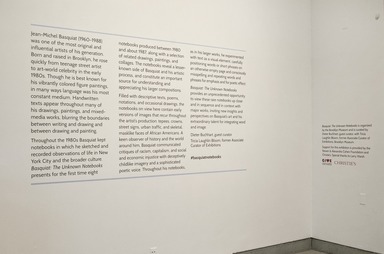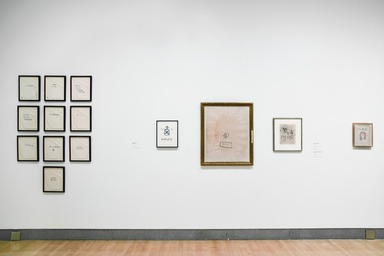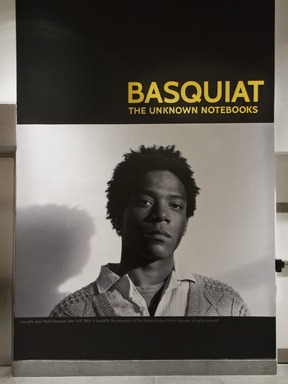

Basquiat: The Unknown Notebooks, April 3, 2015 through August 23, 2015 (Image: DIG_E_2015_Basquiat_The_Unknown_Notebooks_01_PS4.jpg Brooklyn Museum photograph, 2015)
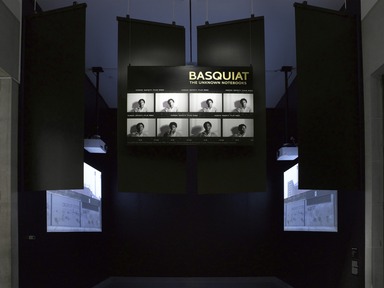
Basquiat: The Unknown Notebooks, April 3, 2015 through August 23, 2015 (Image: DIG_E_2015_Basquiat_The_Unknown_Notebooks_02_PS4.jpg Brooklyn Museum photograph, 2015)
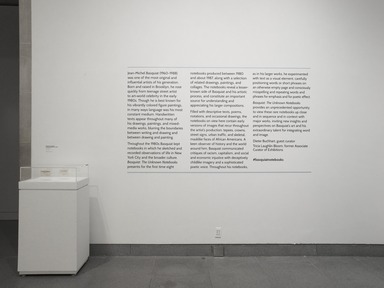
Basquiat: The Unknown Notebooks, April 3, 2015 through August 23, 2015 (Image: DIG_E_2015_Basquiat_The_Unknown_Notebooks_03_PS4.jpg Brooklyn Museum photograph, 2015)
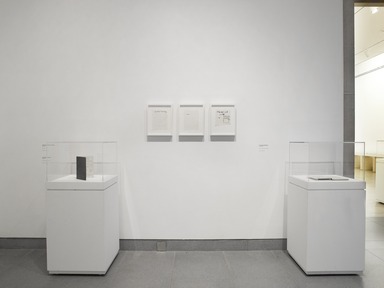
Basquiat: The Unknown Notebooks, April 3, 2015 through August 23, 2015 (Image: DIG_E_2015_Basquiat_The_Unknown_Notebooks_04_PS4.jpg Brooklyn Museum photograph, 2015)
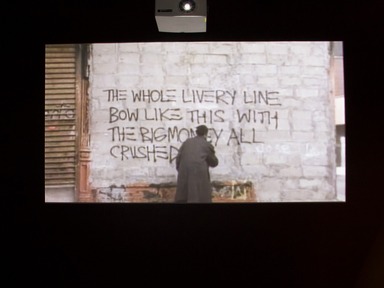
Basquiat: The Unknown Notebooks, April 3, 2015 through August 23, 2015 (Image: DIG_E_2015_Basquiat_The_Unknown_Notebooks_05_PS4.jpg Brooklyn Museum photograph, 2015)

Basquiat: The Unknown Notebooks, April 3, 2015 through August 23, 2015 (Image: DIG_E_2015_Basquiat_The_Unknown_Notebooks_06_PS4.jpg Brooklyn Museum photograph, 2015)
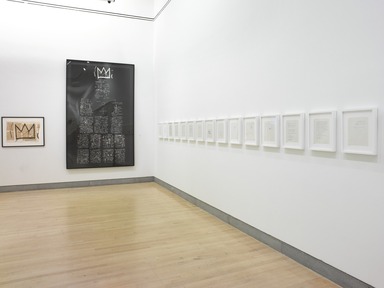
Basquiat: The Unknown Notebooks, April 3, 2015 through August 23, 2015 (Image: DIG_E_2015_Basquiat_The_Unknown_Notebooks_07_PS4.jpg Brooklyn Museum photograph, 2015)

Basquiat: The Unknown Notebooks, April 3, 2015 through August 23, 2015 (Image: DIG_E_2015_Basquiat_The_Unknown_Notebooks_08_PS4.jpg Brooklyn Museum photograph, 2015)
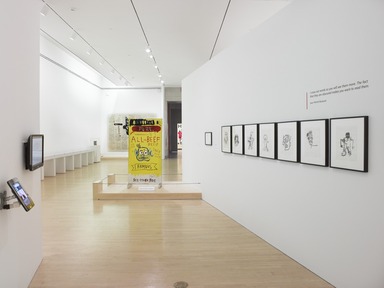
Basquiat: The Unknown Notebooks, April 3, 2015 through August 23, 2015 (Image: DIG_E_2015_Basquiat_The_Unknown_Notebooks_09_PS4.jpg Brooklyn Museum photograph, 2015)
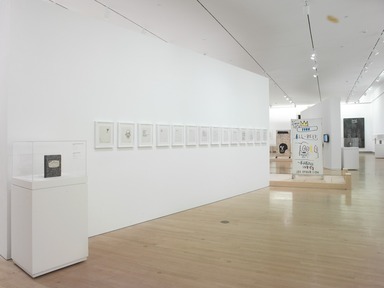
Basquiat: The Unknown Notebooks, April 3, 2015 through August 23, 2015 (Image: DIG_E_2015_Basquiat_The_Unknown_Notebooks_10_PS4.jpg Brooklyn Museum photograph, 2015)

Basquiat: The Unknown Notebooks, April 3, 2015 through August 23, 2015 (Image: DIG_E_2015_Basquiat_The_Unknown_Notebooks_11_PS4.jpg Brooklyn Museum photograph, 2015)
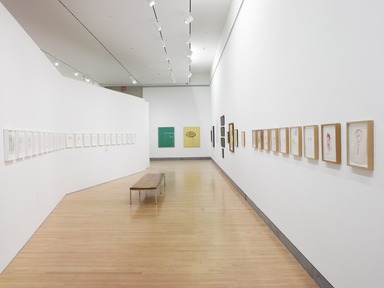
Basquiat: The Unknown Notebooks, April 3, 2015 through August 23, 2015 (Image: DIG_E_2015_Basquiat_The_Unknown_Notebooks_12_PS4.jpg Brooklyn Museum photograph, 2015)

Basquiat: The Unknown Notebooks, April 3, 2015 through August 23, 2015 (Image: DIG_E_2015_Basquiat_The_Unknown_Notebooks_13_PS4.jpg Brooklyn Museum photograph, 2015)

Basquiat: The Unknown Notebooks, April 3, 2015 through August 23, 2015 (Image: DIG_E_2015_Basquiat_The_Unknown_Notebooks_14_PS4.jpg Brooklyn Museum photograph, 2015)
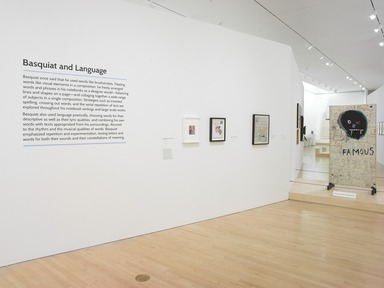
Basquiat: The Unknown Notebooks, April 3, 2015 through August 23, 2015 (Image: DIG_E_2015_Basquiat_The_Unknown_Notebooks_15_PS4.jpg Brooklyn Museum photograph, 2015)
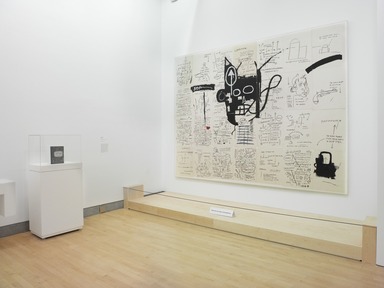
Basquiat: The Unknown Notebooks, April 3, 2015 through August 23, 2015 (Image: DIG_E_2015_Basquiat_The_Unknown_Notebooks_16_PS4.jpg Brooklyn Museum photograph, 2015)
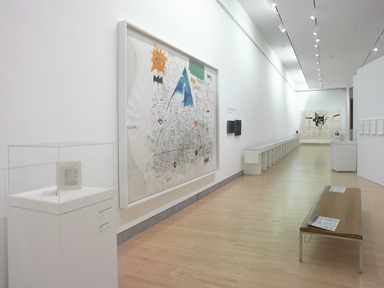
Basquiat: The Unknown Notebooks, April 3, 2015 through August 23, 2015 (Image: DIG_E_2015_Basquiat_The_Unknown_Notebooks_17_PS4.jpg Brooklyn Museum photograph, 2015)

Basquiat: The Unknown Notebooks, April 3, 2015 through August 23, 2015 (Image: DIG_E_2015_Basquiat_The_Unknown_Notebooks_18_PS4.jpg Brooklyn Museum photograph, 2015)
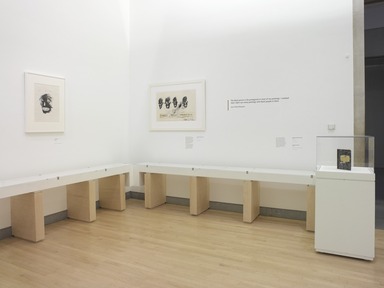
Basquiat: The Unknown Notebooks, April 3, 2015 through August 23, 2015 (Image: DIG_E_2015_Basquiat_The_Unknown_Notebooks_19_PS4.jpg Brooklyn Museum photograph, 2015)

Basquiat: The Unknown Notebooks, April 3, 2015 through August 23, 2015 (Image: DIG_E_2015_Basquiat_The_Unknown_Notebooks_20_PS4.jpg Brooklyn Museum photograph, 2015)
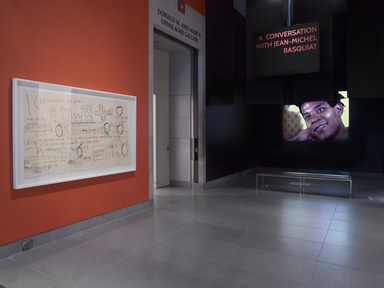
Basquiat: The Unknown Notebooks, April 3, 2015 through August 23, 2015 (Image: DIG_E_2015_Basquiat_The_Unknown_Notebooks_21_PS4.jpg Brooklyn Museum photograph, 2015)
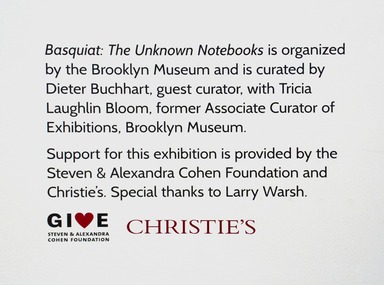
Basquiat: The Unknown Notebooks, April 3, 2015 through August 23, 2015 (Image: DIG_E_2015_Basquiat_The_Unknown_Notebooks_22_PS4.jpg Brooklyn Museum photograph, 2015)
Basquiat: The Unknown Notebooks
-
Basquiat: The Unknown Notebooks
Jean-Michel Basquiat (1960–1988) was one of the most original and influential artists of his generation. Born and raised in Brooklyn, he rose quickly from teenage street artist to art-world celebrity in the early 1980s. Though he is best known for his vibrantly colored figure paintings, in many ways language was his most constant medium. Handwritten texts appear throughout many of his drawings, paintings, and mixed-media works, blurring the boundaries between writing and drawing and between drawing and painting.
Throughout the 1980s Basquiat kept notebooks in which he sketched and recorded observations of life in New York City and the broader culture. Basquiat: The Unknown Notebooks presents for the first time eight notebooks produced between 1980 and about 1987, along with a selection of related drawings, paintings, and collages. The notebooks reveal a lesser-known side of Basquiat and his artistic process, and constitute an important source for understanding and appreciating his larger compositions.
Filled with descriptive texts, poems, notations, and occasional drawings, the notebooks on view here contain early versions of images that recur throughout the artist’s production: tepees, crowns, street signs, urban traffic, and skeletal, masklike faces of African Americans. A keen observer of history and the world around him, Basquiat communicated critiques of racism, capitalism, and social and economic injustice with deceptively childlike imagery and a sophisticated poetic voice. Throughout his notebooks, as in his larger works, he experimented with text as a visual element, carefully positioning words or short phrases on an otherwise empty page and consciously misspelling and repeating words and phrases for emphasis and for poetic effect.
Basquiat: The Unknown Notebooks provides an unprecedented opportunity to view these rare notebooks up close and in sequence and in context with major works, inviting new insights and perspectives on Basquiat’s art and his extraordinary talent for integrating word and image.
Basquiat: The Unknown Notebooks is organized by the Brooklyn Museum and is curated by Dieter Buchhart, guest curator, with Tricia Laughlin Bloom, former Associate Curator of Exhibitions, Brooklyn Museum.
Support for this exhibition is provided by the Steven & Alexandra Cohen Foundation and Christie’s. Special thanks to Larry Warsh. -
About the Notebooks
The total number of notebooks created by Basquiat remains unknown, but the eight examples on view here, produced between 1980 and about 1987, point to a consistent and deliberate practice that relates to the artist’s larger studio work in illuminating ways.
His choice of readily available marble composition books is in keeping with Basquiat’s interest in everyday objects. Even when he could have afforded more durable materials, he continued to use the inexpensive composition book, available at dime stores and corner delis. In composing these notebooks, Basquiat generally left the reverse side of each page blank. This format creates a clean, open space facing each text and allows each page to function independently.
Basquiat’s controlled penmanship and conscious use of all- capital letters give the notebook writings an ornamental appearance that sets them apart from mundane note taking or traditional sketches. Best understood as autonomous works of art rather than preparatory studies for larger compositions, the notebooks often contain words and ideas that are not found in Basquiat’s larger works. -
High and Low
Basquiat’s subjects are a heady blend of high- and pop-culture influences. Raised in a multilingual home——his mother was of Puerto Rican descent, his father from Haiti——Basquiat was a student of art history and world culture, visiting the museums of New York City from a young age. He was also, from an early age, an avid reader, draftsman, and critical thinker. Often paying tribute in his works to great figures of Western art and literature——artists such as Gerard ter Borch and Leonardo da Vinci and writers including Herman Melville and Mark Twain——he cleverly acknowledged both the significance of high culture and his own relationship to art-historical and literary traditions.
In the notebooks and other works, these references are juxtaposed with allusions to pop stars and athletes, everyday sights and sounds of urban life——children’s games, city traffic, jazz music, advertisements, news headlines, and random incidents——and even shopping lists, phone numbers, and personal notations. -
Basquiat and Language
Basquiat once said that he used words like brushstrokes. Treating words like visual elements in a composition, he freely arranged words and phrases in his notebooks as a designer would—balancing lines and shapes on a page—and collaging together a wide range of subjects in a single composition. Strategies such as inverted spelling, crossing out words, and the serial repetition of text are explored throughout his notebook writings and large-scale works.
Basquiat also used language poetically, choosing words for their descriptive as well as their lyric qualities, and combining his own words with texts appropriated from his surroundings. Attuned to the rhythm and the musical qualities of words, Basquiat emphasized repetition and experimentation, testing letters and words for both their sounds and their constellations of meaning. -
If you read the canvases out loud to yourself, the repetition, the rhythm, you can hear Jean-Michel thinking.
Fred Brathwaite (Fab Five Freddy)
I cross out words so you will see them more. The fact that they are obscured makes you want to read them.
Jean-Michel Basquiat
The black person is the protagonist in most of my paintings. I realized that I didn’t see many paintings with black people in them. Jean-Michel Basquiat
-
October 1, 2014
Press Preview Thursday, April 2
Eight rarely seen notebooks created by Jean-Michel Basquiat between 1980 and 1987 that have never before been presented to the public form the core of a new exhibition, Basquiat: The Unknown Notebooks, on view at the Brooklyn Museum from April 3 through August 23, 2015. The exhibition features 160 unbound notebook pages, filled with the artist’s handwritten texts and sketches, along with thirty related paintings, drawings, and mixed-media works drawn from private collections and the artist’s estate.
Born in Brooklyn in 1960, Basquiat had a prolific career, producing some 600 paintings, 1,500 drawings, and a small group of sculptures and mixed-media work before his untimely death in 1988 at the age of twenty-seven. His life and meteoric rise to fame has become legendary, both within the art world and in popular culture—mythologized in films and referenced by hip-hop and rap artists. The child of a Haitian father and Puerto Rican mother, Basquiat was fluent in French, Spanish, and English. With his mother he made frequent visits to New York City’s museums, including the Brooklyn Museum, where he was a Junior Member. A self-taught artist, Basquiat first came to public attention in the late 1970s for the aphorisms he spray-painted around lower Manhattan under the pseudonym SAMO©. In 1978 Basquiat left Brooklyn for good and moved to Manhattan, living on the streets and with friends and selling handmade postcards. Basquiat exhibited his art publicly for the first time in 1980 at the Times Square Show, and his career as a studio artist and international celebrity followed a rapid trajectory from that point onward.
In developing a visual language aimed at undermining social hierarchies and rules, Basquiat took inspiration from comics, children’s drawings, advertising, and Pop art, from Aztec, African, Caribbean, Greek, and Roman culture, and from everyday life. In his large-scale works he engaged in an exploration of culture and society, combining historical and popular themes. His notebooks demonstrate how he began to develop these artistic strategies.
Language was an early medium for Basquiat, and words are an integral part of the notebooks and the large-scale figurative paintings for which he is b est known. Handwritten texts run throughout his diverse product ion, blurring the lines between writing and drawing, and between drawing and painting. While the total number of notebooks created by Basquiat remains unknown, the notebooks presented in this exhibition reflect the originality of Basquiat’s thinking and the diversity of his subjects. The eight notebooks in the exhibition and several other works come from the collection of Larry Warsh, a New York–based publisher and early col lector of Basquiat works, who previously served as a member of the Basquiat authentication committee.
Basquiat followed a specific format for his notebook texts, which were written primarily in black ink in b lock capital lettering sim ilar to that of his street graffiti. Writing only on the right-hand pages, leaving the reverse sides blank, he used color sparingly in the notebooks, with a few exceptions.
Early sketches of subjects that recur in later works, such as tepees, skeletal faces, and crowns, appear in the earliest notebooks from 1980–81. The notebook writings range from ext ended narrative poems and wordplay to observations of New York’s street life, a long with lists of celebrities and incidental notes from the artist’s personal life. As in his paintings, fragments of found texts appear throughout the notebooks, incorporating street signage, news stories, and references from literature and the Old Testament. Other pages reflect Basquiat’s overriding interest in highlighting racial discrimination and acknowledging the important contributions of African Americans and other people of color, as well as his interests in m usic, world history, and popular culture.
The exhibition, which will tour to venues to be announced, has been organized for the Brooklyn Museum by Dieter Buchhart, independent curator and Basquiat scholar, and Tricia Laughlin Bloom, Associate Curator of Exhibitions, Brooklyn Museum.
The exhibition w ill be accompanied by a fully illustrated catalogue published by the Brooklyn Museum and Skira Rizzoli. The volume includes essays by Dieter Buchhart; Henry Louis Gates, Jr., Alphonse Fletcher University Prof essor and Director of the W. E. B. Du Bois Institute for African and African A merican Research at Harvard University; Frank lin Sirmans, Depart ment Head and Curator of Contemporary Art at the Los Angeles County Museum and a co-curator of the Brooklyn Museum’s acclaimed 2005 exhibition Basquiat; and Christopher Stackhouse, a Brooklyn-based writer and visual artist.
Support for this exhibition is provided by the Steven & Alexandra Cohen Foundation and Christie's.
Basquiat: The Unknown Notebooks exhibition (2015)
View Original
